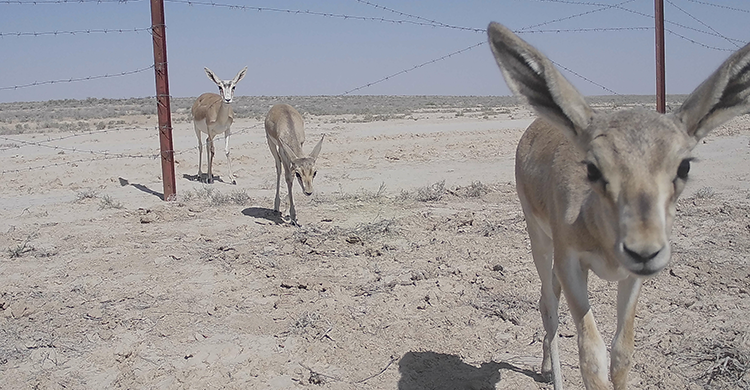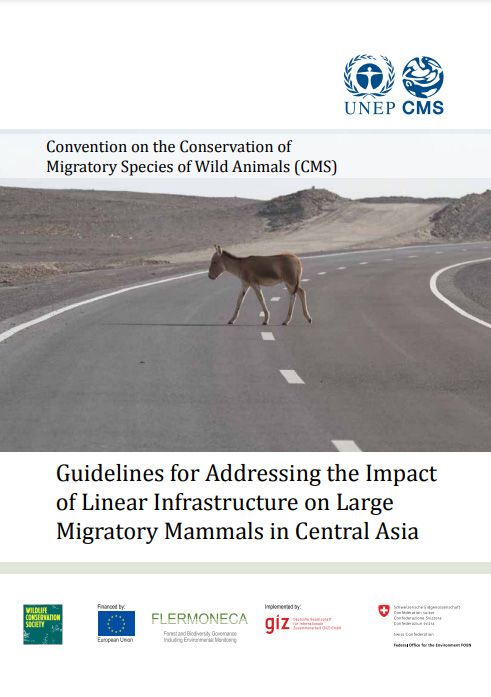Addition of Three Species proposed by Mongolia to the Appendices of CMS

Przewalski’s Horses © Grunewald
Bonn, 12 December 2017 - The CMS Secretariat is pleased to announce the addition of Przewalski’s Horse, Gobi Bear, and Steppe Eagle, all proposed by Mongolia, to the CMS Appendices at COP12.
Przewalski’s Horses were last seen in 1969 in the wild near Mongolian border in Trans-Altai Gobi. The population is currently estimated to consist of more than 50 mature individuals free-living in the wild for the past seven years. This taxon is threatened by small population size and restricted range, potential hybridization with domestic horses, loss of genetic diversity, and disease. As the population size is small, it is vulnerable to stochastic events such as severe weather.
Przewalski’s Horses play a crucial role in the ecosystems where they live. Their grazing helps the vegetation to regrow and the pasture can be re-used by other herbivores. The foals are a main source of food for wolves in Hustai National Park. The remains are scavenged by foxes, vultures and other scavengers.
Gobi Bears are listed as a Critically Endangered population of Brown Bear in the IUCN Red List of Endangered Species, and are found only in the extreme environment of the Gobi Desert of Mongolia. Population estimates indicate that less than 45 remain. Most of the population is found in the Great Gobi Strictly Protected Area in Mongolia; however, GPS satellite telemetry demonstrated that one individual travelled west into the Tien Shan Mountains of China and remained there for about a month before returning.
The Gobi Bear together with Wild Bactrian Camel is considered as an umbrella species of Gobi ecosystem. It means that the conservation of this species will help to protect other wildlife species in the Gobi region. It is expected that at the next CAMI Range State meeting, there will be a discussion about whether this species will also be protected under the CAMI program, thus falling under its Program of Work.
 |
 |
The Steppe Eagle is a migratory raptor which has undergone extremely rapid population declines within its European range and rapid declines in other parts of its range. The speed and severity of these declines justified the species being moved from ‘Least Concern’ to ‘Endangered’ in the 2015 IUCN Red List assessment.
The Steppe Eagle is a higher trophic level species and therefore performs a key role in shaping natural ecosystems. With other soaring birds, it provides important ecological services, particularly in agricultural landscapes where it controls pest populations, such as rodents, and disposes of carrion.
As with all species, listing is only the first step, to be used as a tool to help Parties work together in conserving these three iconic species.
***
Бонн, 12 декабря 2017 - Секретариат КМВ с радостью сообщает, что по предложению правительства Монголии в приложения КМВ на 12-ой Конференции Сторон включены Лошадь Пржевальского, Гобийский бурый медведь и Степной орел!
Лошади Пржевальского были замечены в последний раз в дикой природе в 1969 вблизи монгольской границы. Популяция в настоящее время состоит приблизительно из 50 особей. Небольшой размер популяции и ограниченый диапазон проживания, потенциальная гибридизация с домашними лошадьми, потеря генетического разнообразия и болезни – все это является причиной постепенного исчезновения этого вида. Малочисленность популяции делает Лошадь Пржевальского уязвимой к стохастическим событиям, таким, как суровая погода.
Лошади Пржевальского играют важную роль в экосистемах места обитания. Их выпас способствует росту растений, что обеспечивает возможность использования пастбищ другими травоядными животными. Жеребята - главный источник еды для волков в Национальном парке Hustai. Останки подчищаются лисами, стервятниками и другими падальщиками.
Гобийский медведь (Ursus arctos isabellinus) встречается только в экстремальных условиях пустыни Гоби в Монголии. Статистически точные оценки их численности свидетельствуют о том, что осталось меньше 45 особей. Большая часть популяции находится в строго охраняемом районе Великой пустыни Гоби в Монголии. Однако спутниковая телеметрия GPS продемонстрировала, что одна особь отправилась на запад в горы Тянь-Шаня в Китае и оставалась там около месяца, прежде чем вернуться. Возможно, что гобийские медведи могут обитать и в других районах Тянь-Шаня, куда они мигрировали, но в последнее время такие исследования в этой части Китая не проводились.(Reynolds et al., 2010).
Гобийский медведь вместе с диким двугорбым верблюдом считается зонтичным видом экосистемы Гоби. Это означает, что сохранение этого вида поможет защитить другие виды дикой природы в регионе Гоби.
Степной орел - мигрирующий хищник, который перенес чрезвычайно быстрое уменьшение популяции в европейском ареале и быстрое уменьшение популяции в остальных ареалах проживания. Скорость и серьезность этих сокращений оправдывает перемещение вида в Красной книге МСОП (2015 г.) из «Вызывающее наименьшие опасения» до «Подвергаемый опасности».
Степной орел - высший вид трофического уровня и поэтому выполняет ключевую роль в формировании природных экосистем. Наряду с другими птицами, этот вид играет важную роль в экологии, особенно в сельскохозяйственной сфере, где он помогает сокращать популяции вредителей, таких как грызуны, и избавляться от падали (BirdLifeInternational2015b).
Last updated on 13 December 2017




